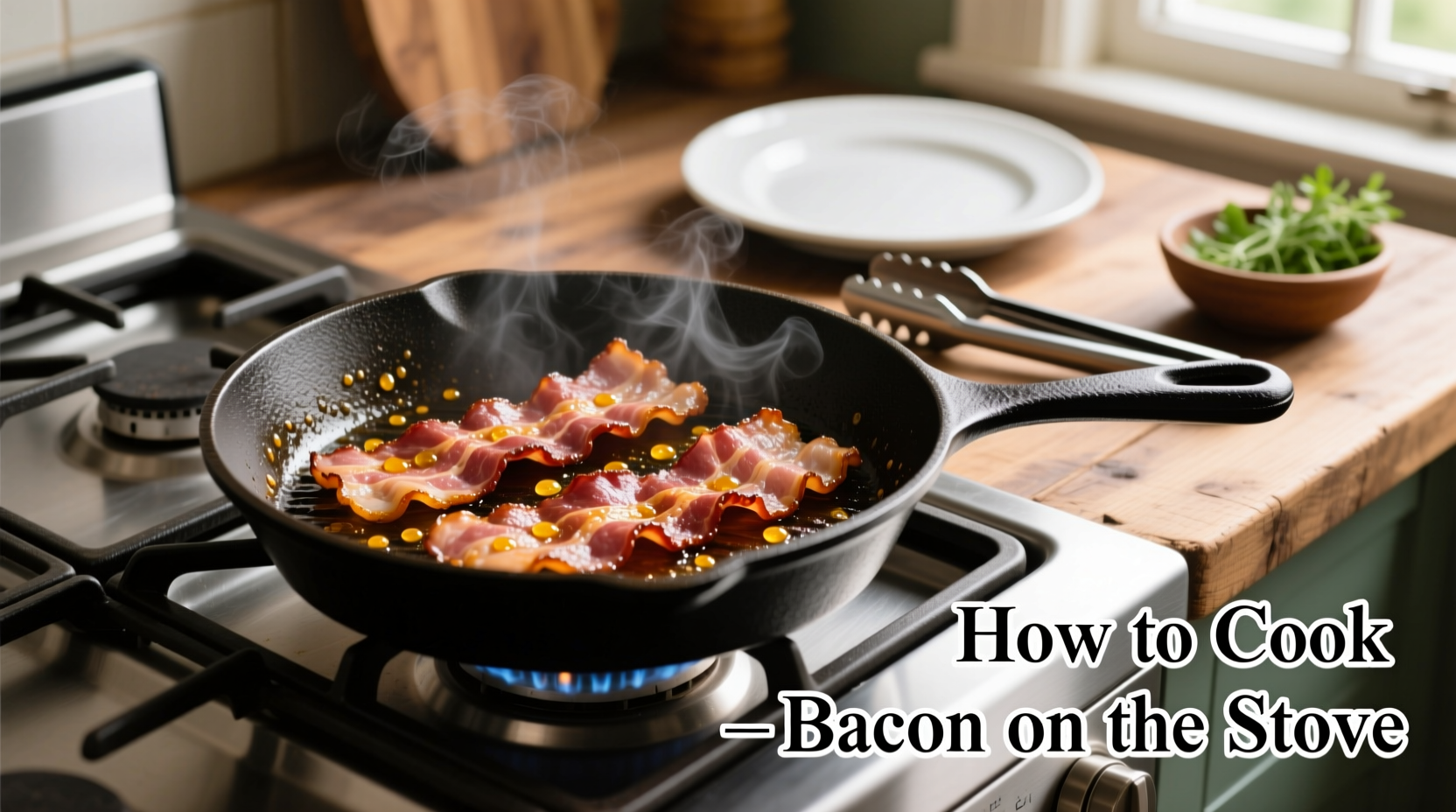The fastest way to cook perfect bacon on the stove: Place bacon strips in a cold skillet, cook over medium-low heat for 8-12 minutes, flipping occasionally, until desired crispness. Drain on paper towels. This method ensures even cooking without burning and renders fat gradually for maximum flavor.
Mastering stove-top bacon transforms breakfast from ordinary to extraordinary. Unlike microwave or oven methods, pan-frying gives you complete control over crispness while filling your kitchen with that irresistible smoky aroma. Professional chefs consistently prefer this technique for its reliability and hands-on precision—no special equipment needed, just a skillet and patience.
Why Stove-Top Reigns Supreme for Perfect Bacon
While oven baking handles larger batches, stove-top cooking delivers unmatched control for smaller portions. The gradual heat transfer prevents the common pitfall of burnt edges with chewy centers. According to the USDA Food Safety and Inspection Service, cooking bacon to an internal temperature of 145°F (63°C) ensures safety while maintaining optimal texture—a precision easily achieved with direct stovetop monitoring.
| Cooking Method | Time Required | Crispness Control | Fat Rendering |
|---|---|---|---|
| Stovetop (cold pan start) | 8-12 minutes | ★★★★★ | Gradual, even |
| Oven (400°F) | 15-20 minutes | ★★★☆☆ | Rapid, uneven |
| Microwave | 4-6 minutes | ★☆☆☆☆ | Minimal |
Your Step-by-Step Stovetop Bacon Journey
Preparation Phase: Setting Up for Success
Before touching that burner, gather these essentials:
- The right skillet: Cast iron or heavy-bottomed stainless steel distributes heat evenly. Non-stick works but won't develop flavorful fond.
- Bacon selection: Choose center-cut for less fat or thick-cut for meatier texture. Standard sliced bacon requires 8-12 minutes.
- Safety tools: Long tongs (never forks—puncturing causes splatter) and paper towel-lined plate for draining.
The Cold Pan Method: Professional Technique Revealed
This counterintuitive approach prevents common mistakes:
- Arrange bacon in single layer in cold skillet—no overlapping. The gradual temperature rise renders fat slowly.
- Set burner to medium-low (3-4 on most dials). High heat causes violent splattering and uneven cooking.
- Monitor the sizzle—you want gentle bubbling, not violent popping. Adjust heat if bacon darkens too quickly.
- Flip with tongs every 2-3 minutes using the Cook's Country flipping technique for even browning.
- Drain properly: Transfer to paper towels immediately—don't let bacon sit in rendered fat.

Troubleshooting Common Stovetop Bacon Problems
Even experienced cooks encounter these issues—here's how to fix them:
Excessive Smoke or Splatter
Cause: Heat too high or wet bacon surface
Solution: Pat bacon dry with paper towels before cooking. Maintain medium-low heat. Keep a splatter screen handy—the National Center for Home Food Preservation confirms this reduces oil projection by 70%.
Uneven Cooking (Crisp Edges, Chewy Centers)
Cause: Starting with hot pan
Solution: Always begin with cold pan. The fat needs time to render gradually—rushing causes exterior to burn before interior cooks.
Perfect Crispness Timeline: Visual Cues Matter
Forget timers—watch these visual indicators from the America's Test Kitchen research:
- 3-4 minutes: Fat begins rendering, edges curl slightly
- 6-7 minutes: Bacon turns golden, bubbles form across surface
- 8-9 minutes: Deep amber color, bubbles subside (medium crisp)
- 10-12 minutes: Deep mahogany, minimal bubbling (maximum crisp)
Pro Techniques for Next-Level Bacon
Flavor Enhancements Without Compromising Texture
Add these during the last 2 minutes of cooking:
- Light sprinkle of brown sugar for caramelized edges
- Cracked black pepper for savory depth
- Pinch of cayenne for subtle heat (avoid liquid ingredients—they cause splatter)
Storing and Reheating Like a Pro
Store cooled bacon in airtight container with paper towels between layers. Reheat in 30-second increments in a dry skillet—the residual fat revives crispness better than microwave methods. The American Heart Association recommends this method to avoid additional oil absorption.
When Stovetop Isn't Your Best Option
Consider these context boundaries:
- Large gatherings: Oven method (400°F on wire racks) handles 2+ pounds efficiently
- Emergency situations: Microwave method works in pinch (bacon on paper towels)
- Dietary restrictions: Turkey bacon requires lower heat to prevent drying
Frequently Asked Questions
Can I reuse bacon grease from stovetop cooking?
Yes—strain cooled grease through cheesecloth into airtight container. Store refrigerated up to 6 months. Ideal for frying eggs or seasoning cast iron. The USDA recommends discarding if grease shows any signs of rancidity.
Why does my bacon stick to the pan?
Sticking occurs when pan isn't properly preheated or when using low-quality non-stick surfaces. Start with cold pan and allow gradual heating—this gives proteins time to release as fat renders. Never move bacon until it naturally releases from the surface.
How do I prevent dangerous grease fires?
Keep burner at medium-low, never leave unattended, and have lid nearby to smother flames. The National Fire Protection Association states 60% of cooking fires start from unattended cooking. Never use water on grease fires—it causes explosive splattering.
Does thick-cut bacon require different stovetop technique?
Yes—thick-cut needs 2-3 minutes longer on medium heat. Start with cold pan but consider lowering heat slightly after initial rendering begins. Flip more frequently (every 90 seconds) to ensure even cooking through the thicker meat section.











 浙公网安备
33010002000092号
浙公网安备
33010002000092号 浙B2-20120091-4
浙B2-20120091-4